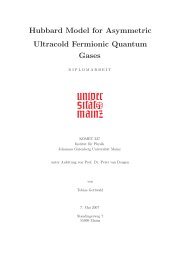5 Hirsch-Fye quantum Monte Carlo method for ... - komet 337
5 Hirsch-Fye quantum Monte Carlo method for ... - komet 337
5 Hirsch-Fye quantum Monte Carlo method for ... - komet 337
You also want an ePaper? Increase the reach of your titles
YUMPU automatically turns print PDFs into web optimized ePapers that Google loves.
5.30 Nils Blümer<br />
K(τ,ω−µ;β)<br />
1<br />
0.8<br />
0.6<br />
0.4<br />
0.2<br />
K s (τ,ω−µ;β)<br />
1<br />
0.8<br />
0.6<br />
0.4<br />
0.2<br />
0<br />
0 10 20 30 40<br />
β(ω−µ)<br />
0<br />
-40 -30 -20 -10 0 10 20 30 40<br />
β(ω−µ)<br />
τ/β = 0.0<br />
τ/β = 0.1<br />
τ/β = 0.2<br />
τ/β = 0.3<br />
τ/β = 0.4<br />
τ/β = 0.5<br />
Fig. 18: General fermion kernel (54) <strong>for</strong> an equidistant set of values of τ/β ≤ 1/2. Except <strong>for</strong><br />
τ = 0, large frequencies are suppressed exponentially. Inset: symmetrized fermion kernel (55).<br />
Be<strong>for</strong>e we address the full analytic continuation problem and introduce the maximum entropy<br />
<strong>method</strong>, we collect some useful relations (denoting them th derivative as G (m) ),<br />
G(β) = n, G(0 + ) = 1−n, (56)<br />
G (m) (0)+G (m) (β) = (−1) m 〈(ω −µ) m 〉A(ω)<br />
(57)<br />
G(β/2) ≈ π<br />
β A(ω)� � . (58)<br />
|ω−µ|�π/β<br />
Since the filling given by (56) is known in the symmetric case, the value ofG(0) then provides<br />
no useful in<strong>for</strong>mation which is also seen in the inset of Fig. 18. Equation (57) also shows the<br />
loss of high-frequency in<strong>for</strong>mation from the discretization of imaginary time: <strong>for</strong> a finite grid<br />
the error in estimating derivativesG (m) increases rapidly with order m; thus, the determination<br />
of high order moments 〈(ω −µ) m 〉A(ω) of the spectrum is in general an ill-posed problem. At<br />
low temperatures, G(β/2) gives a hint as to the weight of a quasiparticle peak or the existence<br />
of a gap via (58) since its value is proportional to the value of the spectral function near the<br />
Fermi energy, averaged over an inverse hyperbolic cosine with widthπ/β.<br />
First attempts to address the analytic continuation problem <strong>for</strong> QMC data included least-squares<br />
fits, Padé approximants, and regularization (<strong>for</strong> references, see the pedagogical and concise<br />
review by Jarrell [56]). Least-squares fits of spectra approximated as a set of box functions<br />
are inherently unstable. Padé approximations <strong>for</strong> G(iωn) only work well <strong>for</strong> very precise data<br />
(e.g., in the context of Eliashberg equations), but not <strong>for</strong> QMC. Regularization of the kernel<br />
(54) tends to produce overly smeared-out spectra. What is needed instead is a regularization of<br />
the solution A(ω) that only shows features which are supported by the data, but is as smooth<br />
as possible otherwise. This is essentially the idea of the maximum entropy <strong>method</strong> (MEM) of<br />
finding the most probable spectrum compatible with the data.













